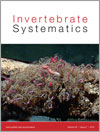Phylogenetic relationships within the superfamily Lycosoidea are investigated through the coding and analysis of character data derived from morphology, behaviour and DNA sequences. In total, 61 terminal taxa were studied, representing most of the major groups of the RTA-clade (i.e. spiders that have a retrolateral tibial apophysis on the male palp). Parsimony and model-based approaches were used, and several support values, partitions and implied weighting schemes were explored to assess clade stability. The morphological–behavioural matrix comprised 96 characters, and four gene fragments were used: 28S (∼737 base pairs), actin (∼371 base pairs), COI (∼630 base pairs) and H3 (∼354 base pairs). Major conclusions of the phylogenetic analysis include: the concept of Lycosoidea is restricted to seven families: Lycosidae, Pisauridae, Ctenidae, Psechridae, Thomisidae, Oxyopidae (but Ctenidae and Pisauridae are not monophyletic) and also Trechaleidae (not included in the analysis); the monophyly of the ‘Oval Calamistrum clade’ (OC-clade) appears to be unequivocal, with high support, and encompassing the Lycosoidea plus the relimited Zoropsidae and the proposed new family Udubidae (fam. nov.); Zoropsidae is considered as senior synonym of Tengellidae and Zorocratidae (syn. nov.); Viridasiinae (rank nov.) is raised from subfamily to family rank, excluded from the Ctenidae and placed in Dionycha. Our quantitative phylogenetic analysis confirms the synonymy of Halidae with Pisauridae. The grate-shaped tapetum appears independently at least three times and has a complex evolutionary history, with several reversions.
How to translate text using browser tools
11 June 2015
Total evidence analysis of the phylogenetic relationships of Lycosoidea spiders (Araneae, Entelegynae)
Daniele Polotow,
Anthea Carmichael,
Charles E. Griswold
ACCESS THE FULL ARTICLE

Invertebrate Systematics
Vol. 29 • No. 2
June 2015
Vol. 29 • No. 2
June 2015




